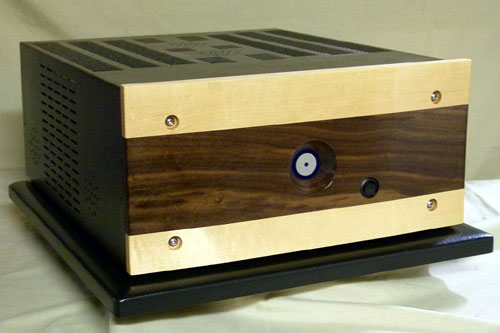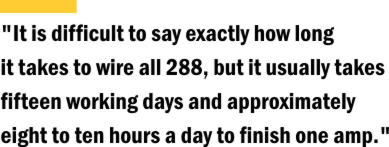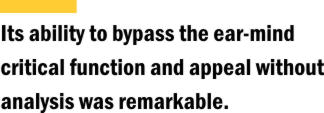Blue
Circle Audio • NSL Stereo Amplifier
"A me-too product it's not. . . ."
With his NSL amplifier, Gilbert has not only introduced a product that will keep his "independent" cred topped off, it may be his best-sounding product ever. Only Gilbert has heard all of the Blue Circle products, but I've heard enough of them to say this with real conviction. The NSL, whose name stands for "Not So Little," is a stereo amp with a topology that lies somewhere outside the solid-state/tube continuum. Instead of using transistors or vacuum tubes to generate power, the NSL has signal op-amps wired in parallel to do the job. "I started to parallel small-signal op-amps about six or seven years ago, when I first began thinking about making a high-quality headphone amp," Gilbert recounted for me. "I paralleled two and then three and then four, etc. Then I started thinking that if I can parallel four, I should able to parallel one thousand, at least in theory." He stopped at 288, which produce the NSL's 28Wpc. Internal pictures of the amp show blocks of those paralleled op-amps -- they are almost all you can see.
If the use of op-amps for a Blue Circle amp sounds somewhat familiar, you are right -- and not quite right. Gilbert previously designed and built amps that use op-amps -- his BC204, '206 and '208 are still available -- but those were power op-amps. They were mounted on their own circuit boards with heatsinks, the number of these modules dictating the amp's power output. The parallel signal op-amps used for the NSL are a completely different matter -- "unique," in Gilbert's words, and he should know. Also unique, at least for a 28Wpc amp, are the more than 2,000,000uF (or two 2 Farads) of power-supply capacitance, a massive amount. Rear-panel features include a pair of speaker binding posts, XLR and RCA inputs, and a ground-lift switch, along with three curious connectors. There is a jack for connecting external battery modules, and a pair of jacks for connecting additional output stages -- more blocks of op-amps. More than anyone I'm aware of, Gilbert has explored the options of battery and even solar power for his equipment. This is normally not possible with a power amp, but the NSL's op-amps make it a reality, the cost being $850 for each module. As for the output stages, these blocks of additional op-amps increase the NSL's power output, the only limiting factor being your budget. The cost begins at $10,000. I've gone on record to say that Blue Circle products look best in the company's standard pairing of stainless-steel faceplate and blue case. You can order the NSL this way, or in just about any combination of wooden faceplate and case color, these representing just another way in which Gilbert refuses to take the well-worn path. he NSL operates in what Gilbert calls "low-bias class AB," eschewing global feedback but having very high local feedback in the output stage, which helps account for the amp's very low output impedance. Gilbert also claims low noise for the NSL, an assertion that's easy to confirm with just a few minutes of listening. The NSL is eerily quiet; whatever comes before it accounts for essentially any noise you hear. Perhaps as a byproduct of this, it also has very low voltage gain, so you may have to lean on the volume control to reach a satisfying listening level. Use with a passive preamp is not recommended, therefore, as dynamics, not to mention overall loudness, will suffer.
As I listened and pondered this, it all seemed to boil down to harmonics and the life they breathed into all music that passed through the NSL. These identifying overtones were especially well defined and well delineated, imparting a sense of immediacy and vividness throughout the mids and into the treble that was neither forced nor unnatural. Piano especially shone, including older recordings like Alexander Brailowsky's playing of Chopin's Preludes from mono LP [Columbia ML 5444], and newer ones like the exceptional Live at Yoshi's Volume 2 [Max Jazz 214] from pianist Jessica Williams -- a demo-quality CD that's also jam packed with vital music. Time and time again, as I worked at the computer in an adjacent room, I scurried out to the listening area just to be sure of what I was hearing, so finely drawn and powerfully real was the music -- especially piano. It was this special way with harmonics that came to define the NSL, literally enlivening all of the music I played and never coming close to aggression in the process. In this way, the NSL was a sonic peculiarity: a component that was both highly detailed and abundantly easeful, presenting the music with precision and naturalness. As such, it never wore thin, as precise but unnatural electronics can. Along with this, vocals were tonally evenhanded and well defined in space. They didn't possess the full and rounded physicality of some tube amps, for instance, or even the Blue Circle BC206, et al., as I recall. The sound of the NSL was more finely drawn and, with this, faster off the mark. As a test for the amp's sheer output capabilities, I played "Words of Wonder" from Keith Richards' Main Offender [Virgin V2-86499], still the most impressive-sounding rock recording I've ever heard. The authoritative drum whacks were as explosive as with more powerful amps but also more singular -- better carved out from the rest of the din going on around them. This was the sort of transient completeness that the Ayre MX-Rs were so adept at, and the NSL was achieving it with one-tenth the output power. Even more impressive were some of the cuts from the Jacques Loussier Trio's Baroque Favorites [Telarc CD83516], one in the series of Telarc albums from the foremost reinterpreter of classical music in a jazz idiom. All of the Loussier Trio's Telarc CDs have the same sonic personality: full, weighty and liquid. I wouldn't be hard-pressed to find a demo cut or two from any of them, a testament to their uniformly excellent sonics. The NSL did its thing with the three instruments -- piano, bass and drums -- portraying all of the fine touches amidst the cavernous space captured on each recording. Bass was quick and, no surprise, well delineated, again retaining the small touches that define it and give it texture. There are some kick-drum wallops on the Loussier CD whose impact I could almost feel with the NSL. Almost. I would not call its bass notably dense or forceful. It was controlled, not gushy or mushy, but a big solid-state bruiser, and even some tube amps, will deliver those kick-drum shots with greater impact and authority. I did wonder, however, if one of the NSL's add-on output stages, and the added output power it would bring, would increase the amp's low-end power. It only stood to reason. But then reason wasn't part of the NSL's skill set -- in fact, just the opposite. Because of its immediately recognizable rightness and the way it delineated instrumental lines and defined the character of instruments and singers, it was an amp that resisted categorization and analysis. Even after my listening was done, with pages of notes to draw from, this was the dominant impression that the NSL left me with and one that ultimately made listening -- though not writing about it -- easy. While Gilbert might be the only person in the audio industry who would undertake wiring 288 op-amps for an amplifier, the NSL makes a compelling case for all the time and bother, and one that may make even more sense when the amp is paired with high-sensitivity speakers, either horn-loaded or single-driver. Music had "shape" with the NSL. This is a term Roy Gregory often uses in his reviews, and it would be easy to misinterpret it as the bodily presence, the dimension, of the musicians and singers themselves, but that's not what Roy means. He's talking about the musical composition itself and whether its complexity and meaning are served or harmed by the sound. Does the music have a sense of completeness? Does it make sense? If the subjective language of audio reviewing makes you grit your teeth until they crack, you will detest this notion of "shape," which is rooted in one person's interpretation. I not only get it, but I value it. Making sense of music -- or at least trying to -- is why I listen in the first place. In the end, the NSL had "shape" down cold, and as such it will appeal to purposeful, active listeners. It doesn't so much unravel the music as put it back together, aiding with engagement and comprehension. It underscores the fact that the equipment exists because of the music, not the other way around. he most relevant and interesting amp for comparison to the NSL would be one of the other Blue Circle models that use op-amps, even though they are fundamentally different from the NSL. I can say even through distant recollection that the BC204 ($11,695) and BC208 ($31,995 per pair) sound more forceful than the NSL, not only driving speakers that may present an issue to the less powerful amp, but also possessing a character that has more obvious forward momentum and drive. Beyond that, you only have to read the preceding paragraphs to know what I hear in the NSL that the more powerful amps didn't achieve to the same extent: the delineation of instrumental lines, the harmonic complexity and life. While sonic memory is suspect, distant sonic memory is more conjecture than certainty, and that's what I'm relying on here. However, for part of its stay, the NSL shared time in my system with the Analog Domain Artemis monoblocks, the $130,000 chrome-plated Teutonic power stations whose defining trait was the difficulty they caused in trying to define their sound. Even putting aside the obvious differences, including the 1000-watt output of the Analog Domain monoblocks, these two amps, neither of which uses tubes, couldn't be much more unalike. There was a general unpretentiousness about both amps, the Analog Domain amps never overlaying the music with a power-first signature, the NSL having more of a sound, though one defined by the many music-enhancing traits I've already described. The Artemis monoblocks just seemed to take everything in stride, doing their job with utter dynamic assurance and tonal even-handedness. The NSL instilled a sense of drama that the German amps didn't, even as they couldn't, for instance, propel the drum whacks on Main Offender with the same velocity and impact or match the Analog Domain amps' bottom-end muscle. In so many ways, listening to these amps one after the other served to define them both better, as they never seemed to agree on the details regarding the music they made. Is one more musically valid, more right, than the other? Is vanilla more right than chocolate? Sometimes, as in this case, it's nice to have a taste of both. hile inside-the-box audio will never be Gilbert Yeung's bag, amplifiers like the NSL prove that his way of doing things not only has its place within the audio industry, it continues to make its mark as well. The NSL is unlike any amp I've reviewed or heard, both for its use of small-signal op-amps as output devices and its sonic character. The harmonic refinement it packs into its 28 watts is truly unique in my experience, bringing music to life in a fresh way. Its overall ease and elemental rendering of transients seem at odds, while its silent background makes it suitable for use with high-sensitivity speakers -- or any speakers, when you consider adding one of the outboard power modules. A me-too product it's not, although the NSL makes a strong case for inclusion among amplifiers with greater mainstream recognition. What Gilbert Yeung, the nonconformist, the iconoclast,
will come up with next is anybody's guess. A preamp powered by plasma? A turntable that
uses the earth's rotation to wind its drive mechanism? The NSL further proves that his
ideas are not just novelties. They add to the breadth of high-end audio and to the
music-listening experience as well, and there aren't many products about which you can
legitimately say that.
|
||||||||||||




 I asked Gilbert the natural
question: how much work is it to wire all those op-amps? "It is difficult to say
exactly how long it takes to wire all 288, but it usually takes fifteen working days and
approximately eight to ten hours a day to finish one amp." So if you're wondering why
the NSL costs what it does, there's your answer: over two weeks of work to build just one
amp -- and "over 12,000 solder joints," according to Gilbert, who has made the
calculations.
I asked Gilbert the natural
question: how much work is it to wire all those op-amps? "It is difficult to say
exactly how long it takes to wire all 288, but it usually takes fifteen working days and
approximately eight to ten hours a day to finish one amp." So if you're wondering why
the NSL costs what it does, there's your answer: over two weeks of work to build just one
amp -- and "over 12,000 solder joints," according to Gilbert, who has made the
calculations. During my listening with
Wilson Audio Alexandria XLF speakers and their 92.5dB sensitivity, I never noticeably
taxed the NSL, but it was still important to keep in mind that it is a 28Wpc amp, so not
appropriate for a multitude of speakers. Given its power output and low noise, it's well
suited for use with horns, and this applies to its sonic character as well. While the NSL
is neither a traditional solid-state amplifier nor one that uses tubes, its sound takes
into account both technologies, not so much adopting an à la carte approach -- the
midrange of tubes and the bass of solid state, for instance -- but rather combining the
general characteristics of both throughout its tonal and dynamic ranges. Right from the
start, the NSL sounded instantly and unambiguously right. Its ability to bypass the
ear-mind critical function and appeal without analysis was remarkable. Piano, horns, and
strings were marked by an effortless ability to cascade into the soundstage, their attack
and decay prolonged. There seemed to be more of the instruments' elemental selves, and
less of an electronic signature, than with so many amps, even exceptional ones.
During my listening with
Wilson Audio Alexandria XLF speakers and their 92.5dB sensitivity, I never noticeably
taxed the NSL, but it was still important to keep in mind that it is a 28Wpc amp, so not
appropriate for a multitude of speakers. Given its power output and low noise, it's well
suited for use with horns, and this applies to its sonic character as well. While the NSL
is neither a traditional solid-state amplifier nor one that uses tubes, its sound takes
into account both technologies, not so much adopting an à la carte approach -- the
midrange of tubes and the bass of solid state, for instance -- but rather combining the
general characteristics of both throughout its tonal and dynamic ranges. Right from the
start, the NSL sounded instantly and unambiguously right. Its ability to bypass the
ear-mind critical function and appeal without analysis was remarkable. Piano, horns, and
strings were marked by an effortless ability to cascade into the soundstage, their attack
and decay prolonged. There seemed to be more of the instruments' elemental selves, and
less of an electronic signature, than with so many amps, even exceptional ones.